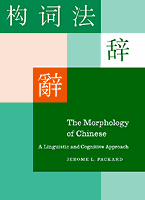The Morphology of Chinese: A Linguistic and Cognitive Approach
by Jerome L. Packard
Cambridge University Press, 2000.
Search bookstores for this title.Publisher's page on this title.
Contents

-
Introduction
sample chapter (PDF format)
- Rationale: why investigate Chinese words?
- The scope of this work
-
Defining the word in Chinese
-
What is a 'word'?: different views
- Orthographic word
- Sociological word
- Lexical word
- Semantic word
- Phonological word
- Morphological word
- Syntactic word
- Psycholinguistic word
-
The Chinese concept of 'word'
- The reality of 'word' in Chinese
- How we will define 'word' in Chinese
-
What is a 'word'?: different views
-
Chinese word components
-
Describing the components
-
Possible descriptions
- Relational desciption
- Modification structure description
- Semantic description
- Syntactic description
- Form class description
-
Possible descriptions
-
Form classes of the components
- Form class identities within words
- Criteria for determining form class of Chinese word components
-
Morphological analysis of Chinese word components
- Distinguishing 'free' and 'bound'
- Distinguishing 'content' and 'function'
-
Morpheme types
- Two types of affix
- Word-forming affixes vs. bound roots
-
Summary and some test cases
- Determiners, classifiers and numerals
- Location morphemes
-
The nature of the components
- Affixes as word components
- Bound roots as word components
- Free ('root') words as word components
-
Describing the components
-
Gestalt Chinese words
- Word types
-
Nouns
-
Noun types
- Noun compound words
- Noun bound root words
- Noun derived words
- Noun grammatical words
- N1-N 2 words: kinds of relations
-
Noun types
-
Verbs
-
Verb types
- Verb compound words
- Verb bound root words
- Verb derived words
- Verb grammatical words
- V1-V2: kinds of relations
-
Resultative verbs
- Three classes of resultatives
- Lexical resultatives vs. syntactic extent resultatives
- Other properties of resultatives
-
Verb-Object words
- The problem
- Previous analyses
-
A proposed solution
- The underlying lexical identity of V-O forms
-
Lexicalization and phrase criteria
- Construal as either word or phrase
-
Verb types
- Nouns and verbs by component form class: statistical tendencies
-
Chinese words: special properties
-
Other word properties: Y.R. Chao's insights
- Versatile-restricted
- Positionally free or bound
-
Other word properties: Y.R. Chao's insights
-
X-bar analysis of Chinese words
- Basic X-bar properties
-
X-bar properties applied to words
- Expectations regarding 'X-bar' notation applied to words
-
X-bar morphology: previous proposals
- Selkirk
- Sadock
-
Other proposals
- Scalise
- Di Sciullo and Williams
-
Discussion of Selkirk and Sadock
-
Problems with the Selkirk proposal
- The limited role of X-1
- Lexical listing of predictable information
-
Problems with the Selkirk proposal
-
Previous X-bar analyses of Chinese words
- Tang
- Sproat and Shih
- An alternative proposal for Chinese X-bar morphology
- The concept of 'head' applied to Chinese words
- The proposed analysis applied to English
-
Lexicalization and Chinese words
- Lexicalization and the relationship between word and constituent
- Lexicalization and the availability of word-internal information
- Lexicalization and grammaticalization
- Lexicalization and the formation of new words
-
Chinese words and the lexicon
- What is 'the lexicon'?
- The lexicon and lexical access
-
Lexical access in Chinese
- Chinese speech comprehension and the lexicon
- Chinese speech production and the lexicon
- Experimental evidence demonstrating whole-word processing
-
The Chinese lexicon: what is 'listed'?
- What is 'listed'?: a proposal
-
Chinese characters and the lexicon
- Character sound and meaning ocme from the natural speech lexicon
- How do characters access the lexicon?
- Is Chinese writing 'ideographic'?
-
Chinese words: conclusions
- What have we discovered about words?
- The reality of the 'word'
- References
- Index
